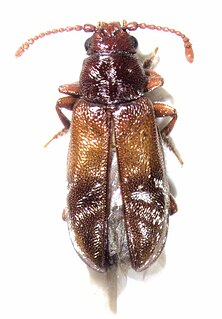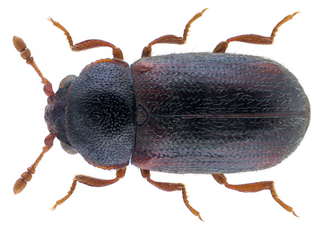
Elateriformia is an infraorder of polyphagan beetles. The two largest families in this group are buprestids, of which there are around 15,000 described species, and click beetles, of which there are around 10,000 described species.

Cucujoidea is a superfamily of beetles. This group formerly included all of the families now included in the superfamily Coccinelloidea. They include some fungus beetles and a diversity of lineages of "bark beetles" unrelated to the "true" bark beetles (Scolytinae), which are weevils.

Cleroidea is a small superfamily of beetles containing about 10,000 species. Most of the members of the group are somewhat slender, often with fairly soft, flexible elytra, and typically hairy or scaly.

Erotylidae, or the pleasing fungus beetles, is a family of beetles containing over 100 genera. In the present circumscription, it contains 6 tribes and 10 subfamilies. In other words, the narrowly circumscribed Erotylidae correspond to the subfamily Erotylinae in the definition sensu lato. There are doubts on the monophyly of lower ranked taxa within Erotylidae, with further phylogenetic studies requiring better sampling and studies of unexplored character sets, for example the metendosternite and penile flagellum, which are generally lacking detailed morphological studies within the Coleoptera literature.
Boganiidae is a family of beetles, in the suborder Polyphaga. Members of the family are found in southern Africa, Australia and New Caledonia. Adults and larvae are pollenivorous, feeding on the pollen of cycads and Myrtaceae, Meliaceae, Cunoniaceae and Elaeocarpaceae angiosperms. Metacucujus and Paracucujus act as pollinators for cycads Encephalartos and Macrozamia respectively. This association with cycads goes back to at least the Mid-Cretaceous, with an extinct form being found with preserved cycad pollen in 99 million year old Burmese amber.

Cavognathidae is a family of beetles, in the superfamily Cucujoidea. It contains a single genus, Taphropiestes with around a dozen species known from South America, Australia and New Zealand. In Australian and New Zealand species adults and larvae have been found living in bird nests, but their ecology is unclear, but they are possibly scavengers.
Lamingtonium is the only genus in the family Lamingtoniidae, of the superfamily Cucujoidea. It contains three species endemic to Australia. The holotype of the type species was collected on at Lamington National Park, Binna Burra, Queensland under the bark of a dead tree. The adults and larvae of two species have been found associated with basidiocarps of fungi belonging to the family Polyporaceae.
Propalticidae is a family of beetles, in the suborder Polyphaga. It contains two genera with the following species:

Sphindidae is a family of beetles, in the suborder Polyphaga. They are also known as slime mold beetles due to their exclusive feeding on slime molds during adult and larval stages, other aspects of their life history are obscure. Palaeontological discoveries since 2015 have added to the geologic history of Sphindidae, including the discovery of Libanopsis, placed in the extinct subfamily Libanopsinae.
Protocucujidae is a family of beetles, in the suborder Polyphaga. It has a single known genus, Ericmodes, of which Protocucujus is a junior synonym. Species of Ericmodes are native to southern South America and Eastern Australia. Little is known of their biology, though adults and larvae probably live on vegetation, with adults having also been found in leaf litter and in flight.
Hymaea is a genus of beetles in the family Phloeostichidae.

Monotomidae is a family of beetles in the superfamily Cucujoidea. The family is found worldwide, with approximately 240 species in 33 genera. The ecological habits of the family are diverse, with different members of the group being found under tree bark, in decaying vegetation, on flowers and in ant nests. Their ecology is obscure, while at least some species are mycophagous, feeding on the fruiting bodies of ascomycete fungi, Rhyzophagus are predators on bark beetles and possibly Phoridae larvae, with the larvae of some species also being mycophagous.
Euxestidae is a family of beetles in the order Coleoptera, formerly included within the family Cerylonidae.
Mychocerus is a genus of minute bark beetles in the family Cerylonidae. There are at least two described species in Mychocerus.

Xenoscelinae is a subfamily of pleasing fungus beetles in the family Erotylidae. There are about 8 genera and 12 described species in Xenoscelinae.

Philothermus is a genus of minute bark beetles in the family Cerylonidae. There are about 17 described species in Philothermus.
Propalticus is a genus of blister beetles in the family Propalticidae. The genus was named and described by David Sharp in 1879.
Eurysphindus is a genus of cryptic slime mold beetles in the family Sphindidae. There are about eight described species in Eurysphindus.

Agapytho is the only genus of beetles in the family Agapythidae. The genus contains a single species, Agapytho foveicollis, which is endemic to New Zealand. Larvae and adults are found on sooty mold growing on Nothofagus trees. Gut contents indicate that at least adult Agapytho consume the sooty mould as part of their diet.









